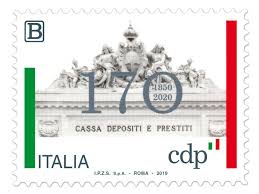POSTE ITALIANE 61^ emissione del 18 novembre 2019 di un francobollo celebrativo della Cassa Depositi e Prestiti S.p.A., nel 170° anniversario della fondazione
POSTE ITALIANE 61^ emissione del 18 novembre 2019 di un francobollo celebrativo della Cassa Depositi e Prestiti S.p.A., nel 170° anniversario della fondazione

Il Ministero dello Sviluppo ha emesso il 18 novembre 2019 un francobollo celebrativo della Cassa Depositi e Prestiti S.p.A., nel 170° anniversario della fondazione, relativo al valore della tariffa B, corrispondente ad €1.10.
- data / date 18 novembre 2019
- dentellatura / serration 11
- stampa / printing rotocalcografia
- tipo di carta / paper type carta patinata gommata, adesiva
- stampato / printed I.P.Z.S. Roma
- tiratura / edition 500.000
- fogli / sheet 45
- dimensioni / dimension 40 x 30 mm
- costo / price B = € 1,10
- bozzettista/ designer a cura della Cassa Depositi e Prestiti e ottimizzato dal centro Filatelico della Direzione Operativa dell’Istituto Poligrafico e Zecca dello Stato S.p.A.
- num. catalogo/catalog num. Michel 4172 YT 3933 UN

Cassa Depositi e Prestiti S.p.A. (CDP) è un’istituzione finanziaria italiana. È una società per azioni, controllata per circa l’83% da parte Ministero dell’economia e delle finanze e per circa il 16% da diverse fondazioni bancarie.
La CDP opera all’interno del sistema economico italiano essenzialmente come una banca di stato, avendo fra le sue diverse attività principali anche la partecipazione nel capitale di rischio delle medie e grandi imprese nazionali, quotate e non, profittevoli e ritenute strategiche per lo sviluppo del Paese.
La principale fonte di raccolta delle risorse finanziarie è costituita da tutto il risparmio postale italiano che CDP gestisce dal 1875. A quest’ultimo, pari a circa 250 miliardi di euro, si aggiunge la raccolta obbligazionaria effettuata sui mercati, sia presso investitori istituzionali sia al dettaglio. Il principale impiego delle risorse finanziarie è rappresentato dai prestiti verso lo Stato e le amministrazioni locali, dall’investimento nel capitale di rischio di imprese italiane che operano anche all’estero e dalla partecipazione in progetti immobiliari, infrastrutturali e finanziari ritenuti strategici per lo sviluppo dell’economia nazionale.
CDP nel perseguire i suoi compiti collabora con le principali istituzioni economiche e finanziarie che operano a livello internazionale e si coordina con gli enti che svolgono un ruolo analogo in altri paesi europei (come la tedesca KfW e la Caisse des dépôts et consignations francese).
Sulla base del valore totale delle attività, pari a 410 miliardi di euro nel bilancio consolidato del 2016, CDP rappresenta la terza istituzione bancaria italiana più grande dopo UniCredit e Intesa Sanpaolo.
Il 5 dicembre 2018 è stato approvato il Piano Industriale 2019-2021 in cui CDP mobiliterà 200 miliardi di euro in tre anni a supporto di imprese, infrastrutture e territorio.
Storia
L’ente venne creato inizialmente col nome di Cassa Piemontese, con la legge del parlamento del Regno di Sardegna n 1097 del 18 novembre 1850. La principale finalità era la mobilizzazione di capitali pervenuti allo Stato attraverso canali di raccolta del risparmio privato per opere di pubblica utilità. Nel 1857 subí una prima riorganizzazione sotto l’impulso del primo governo Cavour.
Dopo l’Unità d’Italia, nel 1863 iniziò ad incorporare le analoghe Casse presenti negli altri Stati progressivamente confluiti nel Regno d’Italia e segue, con la propria sede, gli spostamenti della capitale italiana, prima a Firenze e poi a Roma. L’attività progressivamente si espanse, con la comparsa di nuovi strumenti di raccolta del risparmio, i cui proventi vennero utilizzati per gli scopi istituzionali della CDP, per esempio la realizzazione della linea ferroviaria diretta Roma Napoli.
Nel 1875 il ministro delle finanze Quintino Sella creò le casse di risparmio postali, che utilizzavano la rete degli uffici postali per raccogliere il risparmio degli stati sociali meno agiati, che non avevano accesso alle banche, soprattutto nelle campagne: i depositi avvenivano mediante libretti di risparmio postale. Nel 1896 iniziò l’emissione delle cosiddette Cartelle postali, forma di Titoli di debito pubblico destinata al consolidamento del deficit degli Enti pubblici locali e due anni dopo la Cassa viene trasformata in una direzione generale del Ministero del tesoro.
Su iniziativa di Francesco Saverio Nitti nel 1919 fu fondato il Crediop, di cui la CDP deteneva la maggiore partecipazione. Analogamente nel 1924 la Cassa partecipò alla costituzione dell’ICIPU. Nel 1924 vennero emessi per la prima volta i buoni fruttiferi postali, titoli a rendimento fisso e garantito, di piccolo taglio, tali da raccogliere anche investimenti minimi; l’emissione ebbe un tale successo che, per un certo periodo, viene addirittura sospesa l’emissione dei Buoni Ordinari del Tesoro. L’anno successivo furono emessi Buoni Fruttiferi Postali anche in dollari e sterline, soprattutto ad uso degli emigranti.
Con il tempo cambia anche la forma giuridica della Cassa Depositi e Prestiti che, nata come detto in forma di banca, sia pure sotto l’egida dello Stato, si trasforma prima in una direzione generale del Ministero del tesoro (1898), per divenire poi pienamente autonoma con la promulgazione della legge 13 maggio 1983 n. 197, ed avere quindi il riconoscimento di una propria personalità giuridica, distinta da quella dello Stato, con la legge 19 marzo 1993 n. 68.
Il decreto legge 30 settembre 2003 n. 269 la trasformò in società per azioni subentrando nei diritti e negli obblighi dell’ente; la norma inoltre stabilì che con decreto ministeriale venissero disciplinate le funzioni e le attività della nuova società. La disciplina venne poi emanata con Decreto del Ministero dell’economia e delle finanze 5 dicembre 2003. La trasformazione ne rese la struttura ancora più autonoma, svincolandola almeno in parte dai legami connessi alla precedente forma di ente pubblico. Ciò consentì l’entrata nell’azionariato di 65 fondazioni bancarie alle quali vennero assegnate delle azioni privilegiate pari al 30% del capitale sociale.
Con il 1º gennaio 2006 cambia ancora la struttura operativa, in quanto Cassa Depositi e Prestiti ha effettuato l’incorporazione della società Infrastrutture S.p.A., che era stata costituita dalla stessa CDP nel 2002 allo scopo di finanziare, sotto diverse forme, la realizzazione di infrastrutture e di grandi opere pubbliche. L’ambito di operatività comprende settori diversi: dalla grande industria alla cooperazione internazionale, dallo sviluppo della piccola e media impresa al supporto della loro crescita dimensionale e dell’internazionalizzazione, dal sostegno agli enti pubblici alla gestione del patrimonio immobiliare, dal rilancio delle infrastrutture materiali e immateriali all’agevolazione dell’efficienza energetica e del trasferimento tecnologico.
Caratteristiche principali del Gruppo
Il Gruppo CDP ha fra le sue attività principali i prestiti verso gli enti locali e le imprese, la partecipazione nel capitale sociale delle medie e grandi imprese nazionali profittevoli e ritenute strategiche per lo sviluppo del Paese, il finanziamento di progetti industriali e finanziari ritenuti rilevanti per la crescita del sistema economico italiano. La principale fonte di raccolta delle risorse finanziarie è costituita da tutto il risparmio postale italiano che CDP gestisce dal 1875. A quest’ultimo, pari a circa 250 miliardi di euro, si aggiunge la raccolta obbligazionaria effettuata sui mercati, sia presso investitori istituzionali sia al dettaglio.
Il principale impiego delle risorse finanziarie è rappresentato dai prestiti verso lo Stato e le amministrazioni locali, dall’investimento nel capitale di rischio di imprese italiane che operano anche all’estero e dalla partecipazione in progetti immobiliari, infrastrutturali e finanziari ritenuti strategici per lo sviluppo dell’economia nazionale. La missione principale della CDP, riconosciuta dal 2015 come Istituto Nazionale di Promozione, è promuovere lo sviluppo del sistema economico e industriale dell’Italia, mantenendo un ruolo attivo sullo scenario globale.
Attività
L’attività della società si articola in due distinti rami di azienda:
- “gestione ordinaria”, si occupa del finanziamento di opere, di impianti, di reti e di dotazioni destinati alla fornitura di servizi pubblici e alle bonifiche. Per far fronte a questa attività la Cassa Depositi e Prestiti provvede attraverso l’assunzione di finanziamenti e l’emissione di buoni fruttiferi postali. Contrariamente al risparmio postale, questo tipo di raccolta di fondi non è garantito da parte dello Stato. L’attività è inoltre sottoposta al controllo di una apposita Commissione parlamentare di vigilanza.
- “gestione separata”, gestisce il finanziamento degli investimenti statali e di altri enti pubblici, quali regioni, altri enti locali e comunque strutture afferenti allo Stato, utilizzando quale fonte principale di provvista la raccolta del risparmio postale. Nel dicembre 2003, la Cassa aveva 57 miliardi di euro di crediti verso tali enti, e una raccolta di oltre 200 miliardi di euro nel risparmio postale, in continua crescita. Nel 2008, aveva 99 miliardi di euro disponibili per investimenti strutturali.
Se sei interessato all’acquisto di questo francobollo lo puoi acquistare al prezzo di €1.50. Inviami una richiesta alla email: protofilia1@gmail.com
POSTE ITALIANE 61 ^ issue of 18 November 2019 of a stamp celebrating the Cassa Depositi e Prestiti S.p.A., on the 170th anniversary of the foundation

- data / date 18 novembre 2019
- dentellatura / serration 11
- stampa / printing rotocalcografia
- tipo di carta / paper type carta patinata gommata, adesiva
- stampato / printed I.P.Z.S. Roma
- tiratura / edition 500.000
- fogli / sheet 45
- dimensioni / dimension 40 x 30 mm
- costo / price B = € 1,10
- bozzettista/ designer a cura della Cassa Depositi e Prestiti e ottimizzato dal centro Filatelico della Direzione Operativa dell’Istituto Poligrafico e Zecca dello Stato S.p.A.
- num. catalogo/catalog num. Michel 4172 YT 3933 UN
Cassa
Depositi e Prestiti S.p.A. (CDP)
is an Italian financial institution. It is a joint stock company, controlled
for about 83% by the Ministry of Economy and Finance and for about 16% by
various banking foundations.
CDP operates within the Italian economic
system essentially as a state bank, having among its various main activities
also the participation in risk capital of medium-sized and large domestic
companies, listed and not, profitable and considered strategic for the
development of the country.
The main source for the collection of
financial resources is all the Italian postal savings that CDP has managed since
1875. To the latter, amounting to about EUR 250 billion, is added the bond
collection carried out on the markets, both at institutional and retail
investors. Loans to the State and local authorities are the main use of
financial resources, from the investment in risk capital of Italian companies
that also operate abroad and from the participation in real estate,
infrastructure and financial projects considered strategic for the development
of the national economy.
CDP in carrying out its tasks collaborates
with the main economic and financial institutions operating at international
level and coordinates with bodies that play a similar role in other European
countries (as the German KfW and the French caisse des dépôts et
consignations).
Based on the total value of assets, amounting
to EUR 410 billion in the 2016 consolidated financial statements, CDP is the
third largest Italian banking institution after unicredit and Intesa Sanpaolo.
On December 5, 2018 was approved the
Industrial Plan 2019-2021 in which CDP will mobilise 200 billion euros in three
years to support businesses, infrastructure and territory.
History
The institution was initially created with
the name Cassa Piemontese, with the law of the Parliament of the Kingdom of
Sardinia n 1097 of 18 November 1850. The main purpose was the mobilization of
capital received by the State through private saving collection channels for
public utilities. In 1857 it underwent a first reorganization under the impulse
of the first Cavour government.
After the unification of Italy, in 1863 began
to incorporate the analogous Casse present in the other States progressively
converged in the Kingdom of Italy and follows, with its own headquarters, the
movements of the Italian capital, first in Florence and then in Rome. The
activity progressively expanded, with the appearance of new instruments of
collection of the saving, whose proceeds were used for the institutional
purposes of the CDP, for example the realization of the direct railway line
Rome Naples.
In 1875, the finance minister Quintino Sella
created the postal savings banks, which used the post office network to raise
the savings of less wealthy social states, which did not have access to banks,
especially in the countryside: deposits were
made through postal savings accounts. In
1896 he began issuing the so-called Postal Folders, form of government debt
securities designed to consolidate the deficit of local public authorities and
two years later the Cassa is transformed into a general directorate of the
Ministry of Treasury.
On the initiative of Francesco Saverio nitti in
1919, Crediop was founded, of which the CDP held the largest shareholding. Similarly in 1924 the Cassa participated in the
establishment of ICIPU. In 1924, for the first time, postal savings certificates,
fixed-yield securities and securities with a small denomination were issued,
which also raised minimal investments; the issue was so successful that, for a certain period, The issue of
ordinary Treasury bonds is even suspended. The following year, interest-bearing certificates were also issued in
dollars and pounds, mainly for the use of emigrants.
Over time, the legal form of the Deposits and
Loans Fund has also changed and, born as said in the form of a bank, albeit
under the aegis of the State, it is first transformed into a
Directorate-General of the Treasury (1898)to become fully autonomous with the
promulgation of the law 13 May 1983 n. 197, and thus have the recognition of
its own legal personality, distinct from that of the State, by the law 19 March
1993 n. 68.
The decree law of 30 September 2003 n. 269 transformed it into a joint stock
company taking over the rights and obligations of the entity; the norm
moreover established that by ministerial decree the functions and the
activities of the new society would be disciplined. The discipline was
then issued by Decree of the Ministry of Economy and Finance December 5, 2003.
The transformation made the structure even more autonomous, freeing it at least
in part from the links connected to the previous form of public body. This
enabled the participation of 65 banking foundations to which 30% of the share
capital was allocated preference shares.
On 1 January 2006 the operating structure
changed again, as Cassa Depositi e Prestiti acquired Infrastrutture S.p.A.,
which had been set up by CDP in 2002 with the aim of financing, in various
forms, the construction of infrastructure and major public works. The scope of operations includes different sectors:
from large-scale industry to international cooperation, from the development of
small and medium-sized enterprises to the support of their growth in size and
internationalisation, from support to public bodies to the management of real
estate, from the revival of tangible and intangible infrastructures to the
facilitation of energy efficiency and technology transfer.
Main features of the Group
The CDP Group has among its main activities
loans to local authorities and businesses, the participation in the share
capital of medium and large national companies profitable and considered
strategic for the development of the country, the financing of industrial and
financial projects considered important for the growth of the Italian economic
system. The main source for the
collection of financial resources is all the Italian postal savings that CDP
has managed since 1875. To the latter, amounting to about EUR 250 billion, is
added the bond collection carried out on the markets, both at institutional and
retail investors.
Loans to the State and local authorities are the
main use of financial resources, from the investment in risk capital of Italian
companies that also operate abroad and from the participation in real estate,
infrastructure and financial projects considered strategic for the development
of the national economy. The main mission of the CDP, recognized
since 2015 as National Institute of Promotion, is to promote the development of
Italy’s economic and industrial system, maintaining an active role on the
global scenario.
Activities
The activity of the society is articulated in two distinct branches of company:
• “ordinary management” covers the financing of works, installations,
networks and endowments for the provision of public services and for the
reclamation. To cope with this activity, the Deposits and Loans Fund
provides through the assumption of loans and the issuance of postal savings
certificates. Unlike postal savings, this type of fundraising is not
guaranteed by the State. The work is also supervised by a special
Parliamentary Supervisory Committee.
• “separate management” means the financing of state investment and
other public bodies, such as regions, other local authorities and in any case
state-related structures, using postal savings as the main source of
stock. In December 2003, the Bank had EUR
57 billion in loans to these entities, and a collection of more than EUR 200
billion in postal savings, which is growing steadily. In 2008, it had EUR 99 billion available for
structural investment.
If you are interested in buying the stamp you can buy it for € 1.50. Send me a request to the email: protofilia1@gmail.com







